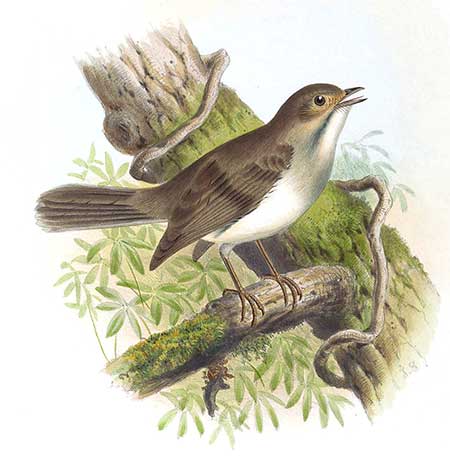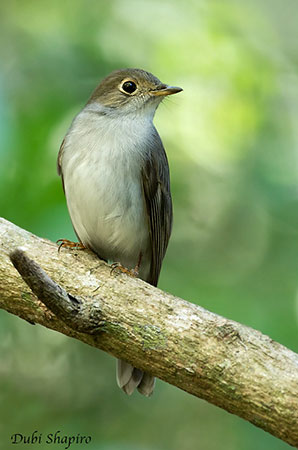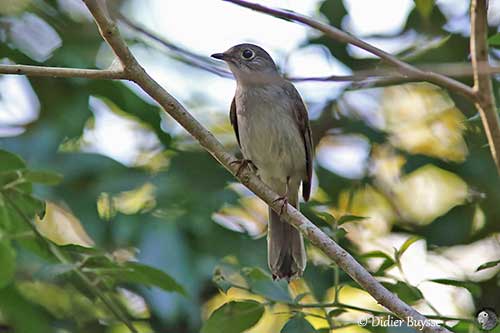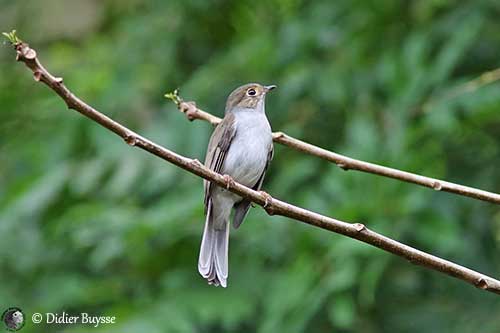
Fr: Solitaire de Cuba
Ang: Cuban Solitaire
All: Kubaklarino
Esp: Solitario Cubano
Ita: Solitario di Cuba
Nd: Cubaanse Solitaire
Sd: kubasolitärtrast
Photographers:
Didier Buysse
Vision d’Oiseaux
Dubi Shapiro
Dubi Shapiro Photo Galleries
Illustrator :Joseph Smit (1836-1929)
Text by Nicole Bouglouan
Sources :
HANDBOOK OF THE BIRDS OF THE WORLD Vol 10 by Josep del Hoyo-Andrew Elliott-David Christie - Lynx Edicions - ISBN: 8487334725
THRUSHES by Peter Clement and Ren Hathway – HELM - ISBN: 0713639407
Arthur Grosset's Birds (Arthur Grosset)
Neotropical Birds – Cornell Lab of Ornithology
Cuba Explorer - Birds of Cuba - Endemic and near endemic birds of Cuba
Source de l’illustration :
Myiadestes elizabethae=Myadestes elisabeth – 1869
Exotic ornithology : containing figures and descriptions of new or rare species of American birds
Cuban Solitaire
Myadestes elisabeth
Passeriformes Order – Turdidae Family
INTRODUCTION:
The Cuban Solitaire is endemic to Cuba where it is sedentary. It lives in restricted habitat in the mountains of the far W and the extreme E of Cuba. The subspecies “retrusus” found on the Isle of Pines is now considered extinct.
This species is threatened by habitat loss through deforestation for agriculture expansion.
The Cuban Solitaire is known for its amazing song, and it is often considered the best songster in Cuba and the West indies where it is named “Ruiseñor”, that means “Nightingale”.
DESCRIPTION OF THE BIRD:
Biometrics:
Length: 19-21 cm
Weight: 22-33 g
The Cuban Solitaire has olive-brown head and upperparts. On the upperwing, tertials, base of secondaries and edges of primaries are warmer brown. The tail is olive-brown with whitish outer rectrices.
The underparts are dull whitish with greyer tinge on the breast.
On the head, the crown is brown, slightly darker than the upperparts. We can see a narrow, whitish eyering. Lores and a broad submoustachial area are dull whitish. There is a narrow, dark brown malar stripe.
The bill is blackish with horn-coloured base of lower mandible. The eyes are dark brown. Legs and feet are brownish to yellowish-brown.
Male and female are similar.
The juvenile resembles adult, but the upperparts are spotted and flecked with buff, whereas on the underparts, breast and flanks are mottled brown.

SUBSPECIES AND RANGE:
The Cuban Solitaire has two subspecies.
M.e. elisabeth is found in W and E Cuba.
M.e. retrusus was found on Isle of Pines. It was slightly greyer on the upperparts than nominate, and had pale buff pre-ocular supercilium. The underparts were pure white. This race is now considered extinct, without any observation since 1970s.
HABITAT:
The Cuban Solitaire frequents dense humid, deciduous and pine forests. It breeds in areas with steep limestone outcrops, rocks and cliffs.
CALLS AND SONGS: SOUNDS BY XENO-CANTO
The Cuban Solitaire is one of the best songsters of Cuba and the West Indies. Its local name “Ruiseñor” pays tribute to the sheer beauty and versatility of its song.
The song is a series of sustained, flute-like, harsh or discordant “zheeee” or “zhe-ee-ee-e” notes, repeated at varying pitch and interspersed with higher, melodious whistles, but also short scratching notes, short warbles and trills.
This sound is far-carrying and uttered from perch within the tree canopy.
The call is a short whistle.
REPRODUCTION OF THIS SPECIES:
The breeding season takes place between February and July.
The cup-shaped nest is made with palm fibres, rootlets, hair, moss and lichens. It is usually concealed by some vegetation. It is built on steep slope or on the side of a bank, but also in hole in tree or in rock crevice on cliff. It can be placed up to 6 metres above the ground.
The female lays 3 greenish eggs with dark spots. In the great majority of cases, the female alone incubates during a period of 11-15 days, depending on species and weather conditions. However, both parents feed and rear the chicks.
PROTECTION / THREATS / STATUS:
The Cuban Solitaire is heavily threatened by habitat loss through deforestation for agriculture and pasture expansion.
The species is described as “fairly common” but it has very restricted range and its population is decreasing.
The Cuban Solitaire is currently classified as Near Threatened.


BEHAVIOUR IN THE WILD:
The Cuban Solitaire feeds on insects caught while hovering at canopy level or by sallying from perch to catch them in flight, or by gleaning prey from leaves. It also consumes small fruits, ripe palm nuts, berries and seeds. It hovers in front of the foliage of trees and bushes to pluck fruits. It may descend to lower vegetation but rarely to the ground.
During the breeding season, the Cuban Solitaire is territorial and monogamous, like most Turdidae. The male sings to proclaim and maintain the territory.
The thrushes of genus Myadestes in the subfamily Myadestinae are known to perform display-flight or aerial song. This behaviour is confined to the breeding season and probably used to attract females, but also to show territorial occupancy to neighbouring males. Courtship feeding probably occurs too.
The Cuban Solitaire is sedentary in Cuba.
In flight, the long wings and tail give the bird great manoeuvrability and power.
